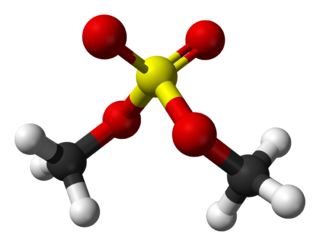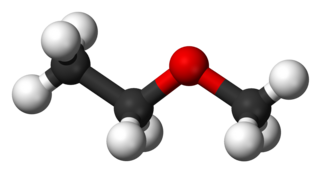
In organic chemistry, ethers are a class of compounds that contain an ether group—an oxygen atom connected to two organyl groups. They have the general formula R−O−R′, where R and R′ represent organyl groups. Ethers can again be classified into two varieties: if the organyl groups are the same on both sides of the oxygen atom, then it is a simple or symmetrical ether, whereas if they are different, the ethers are called mixed or unsymmetrical ethers. A typical example of the first group is the solvent and anaesthetic diethyl ether, commonly referred to simply as "ether". Ethers are common in organic chemistry and even more prevalent in biochemistry, as they are common linkages in carbohydrates and lignin.
Dimethyl ether (DME; also known as methoxymethane) is the organic compound with the formula CH3OCH3, (sometimes ambiguously simplified to C2H6O as it is an isomer of ethanol). The simplest ether, it is a colorless gas that is a useful precursor to other organic compounds and an aerosol propellant that is currently being demonstrated for use in a variety of fuel applications.

Inositol, primarily the isomer myo-inositol, is a carbocyclic sugar that is abundant in the brain and other mammalian tissues; it mediates cell signal transduction in response to a variety of hormones, neurotransmitters, and growth factors and participates in osmoregulation. Concerning regulation of osmosis, in most mammalian cells the intracellular concentrations of myo-inositol are 5 to 500 times greater than the extracellular concentrations.

Phytic acid is a six-fold dihydrogenphosphate ester of inositol, also called inositol hexaphosphate, inositol hexakisphosphate (IP6) or inositol polyphosphate. At physiological pH, the phosphates are partially ionized, resulting in the phytate anion.

Dimethyl sulfate (DMS) is a chemical compound with formula (CH3O)2SO2. As the diester of methanol and sulfuric acid, its formula is often written as (CH3)2SO4 or Me2SO4, where CH3 or Me is methyl. Me2SO4 is mainly used as a methylating agent in organic synthesis.
The molecular formula C6H12O6 (molar mass: 180.16 g/mol) may refer to:
This is the list of extremely hazardous substances defined in Section 302 of the U.S. Emergency Planning and Community Right-to-Know Act. The list can be found as an appendix to 40 CFR 355. Updates as of 2006 can be seen on the Federal Register, 71 FR 47121.

Viscum is a genus of about 70–100 species of mistletoes, native to temperate and tropical regions of Europe, Africa, Asia and Australasia. Traditionally, the genus has been placed in its own family Viscaceae, but recent genetic research by the Angiosperm Phylogeny Group shows this family to be correctly placed within a larger circumscription of the sandalwood family, Santalaceae. Its name is the origin of the English word viscous, after the Latin viscum, a sticky bird lime made from the plants' berries.

Methoxyethane, also known as ethyl methyl ether, is a colorless gaseous ether with the formula CH3OCH2CH3. Unlike the related dimethyl ether and diethyl ether, which are widely used and studied, this mixed alkyl ether has no current applications. It is a structural isomer of isopropyl alcohol. Its utility as an anesthetic and solvent have been investigated.

scyllo-Inositol is one of the stereoisomers of inositol. It is also known as scyllitol, cocositol, quercinitol, and 1,3,5/2,4,6-hexahydroxycyclohexane. scyllo-Inositol is a naturally occurring plant sugar alcohol found most abundantly in the coconut palm.

neo-Inositol is one of the stereoisomers of inositol. It is one of the nine isomeric forms of cyclohexanehexol; a group of small and chemically very stable polar molecules that have versatile properties. This stereoisomer is naturally occurring, but only in small amounts. It is also known as (1s,2R,3R,4s,5S,6S)-cyclohexane-1,2,3,4,5,6-hexol or 1,2,3/4,5,6-cyclohexanehexol in the IUPAC naming system.

muco-Inositol is a critically important chemical in the gustatory (taste) modality of the mammalian nervous system. The generic form is coupled to a phospholipid of the outer lemma of the sensory neurons associated with the sodium ion sensitive channel of gustation.

1L-chiro-Inositol (L-chiro-Inositol) is one of the isomers of inositol.

Epi-Inositol is one of the stereoisomers of inositol.

cis-Inositol is one of the isomers of inositol.

allo-Inositol is a stereoisomer of inositol.

In organic chemistry, a cyclitol is a cycloalkane containing at least three hydroxyl, each attached to a different ring carbon atom. The general formula for an unsubstituted cyclitol is C
nH
2n-x(OH)
x or C
nH
2nO
x where 3 ≤ x ≤ n.

Allenestrol, or allenoestrol, also known as α,α-dimethyl-β-ethylallenolic acid or as methallenestrilphenol, is a synthetic, nonsteroidal estrogen and a derivative of allenolic acid that was never marketed. A methyl ether of allenestrol, methallenestril (methallenestrol), is also an estrogen, but, in contrast to allenestrol, has been marketed.

Cannabidiol dimethyl ether (CBDD) is a trace component of cannabis which can also be made synthetically. It is a potent and selective inhibitor of the enzyme 15-lipoxygenase and inhibits oxygenation of linoleic acid, a process involved in the development of atherosclerosis.
















